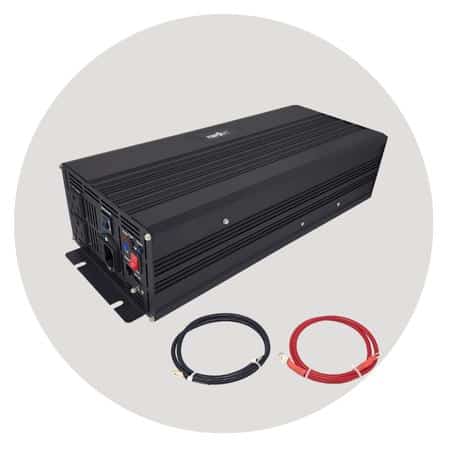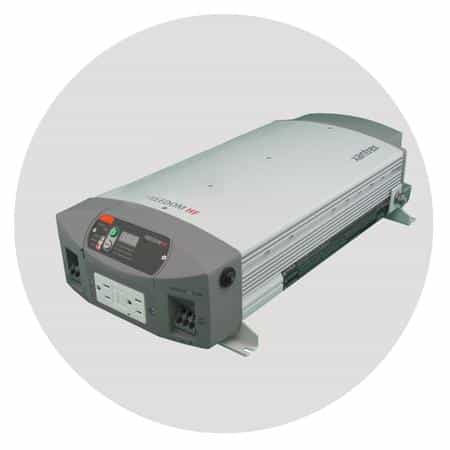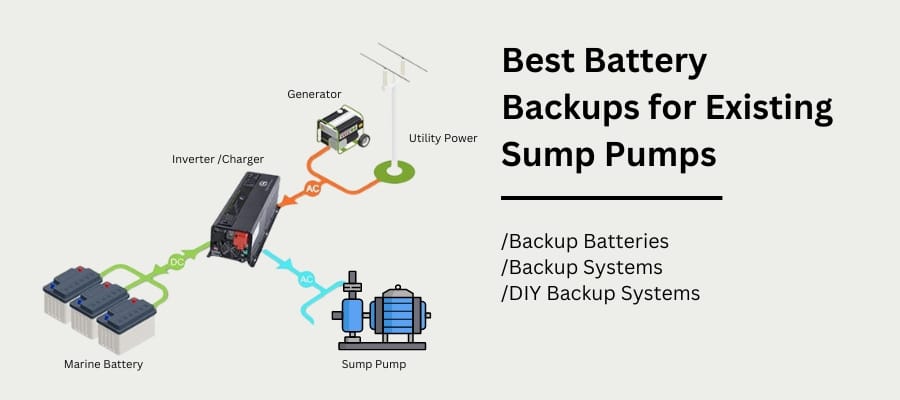
The installation of a backup power for sump pump is often done at the time of the sump pump’s initial installation. But what if you made a mistake and chose a non-battery backup sump pump, only to later realize that you really should have opted for a battery backup instead?
Well, in the past, you would have to physically remove the old sump pump and replace it with a dual sump pump with battery backup, which can be both time-consuming and costly.
A battery backup for a sump pump is the best of the three backup systems since it can keep your basement dry in the event of a power outage or other emergency. We recommend solar or gas generator for sump pump if you want to power more than just sump pump.
Using backup batteries is the most hassle-free option. You can install a battery back up for sump pump that gets power from the batteries into the form (AC) required by the main pump. It could provide additional safety without necessitating the installation of a second pump in the basement pump pit.
A true battery backup for existing sump pump works with the primary sump pump 24 hours and is not a replacement. Battery backup for sump pumps is nothing but a pure sine wave inverter charger with a deep cycle marine battery.
Top 3 Battery Backup System for Sump Pump
Product | Model & Features | Price |
SEC America 822PS - Sump Pump Backup System
| ||
PumpSpy BU1500 Sump Pump Backup Power System
| ||
Xantrex Freedom 806-1840 HF 1800 Inverter Charger
|
In the event of a power outage, a sump pump can become your worst nightmare, but it can also save your home. Thankfully, we now have a range of choices to ensure that our sump pumps keep working in the event of a power outage. If you’re considering purchasing a battery backup, here are four different options to consider:
- Battery backup system for sump pump
- Build your DIY battery backup system with inverter and DC battery (Cheaper option)
- Secondary sum pump with DC battery backup
- Get a generator for sump pump
So, how does a battery backup work for a sump pump? In the event of a power outage, battery backup systems will convert the DC battery power to AC and provide power to the sump pump. While the power is restored, the inverter charger backup system will switch back to AC current and will also charge the battery.
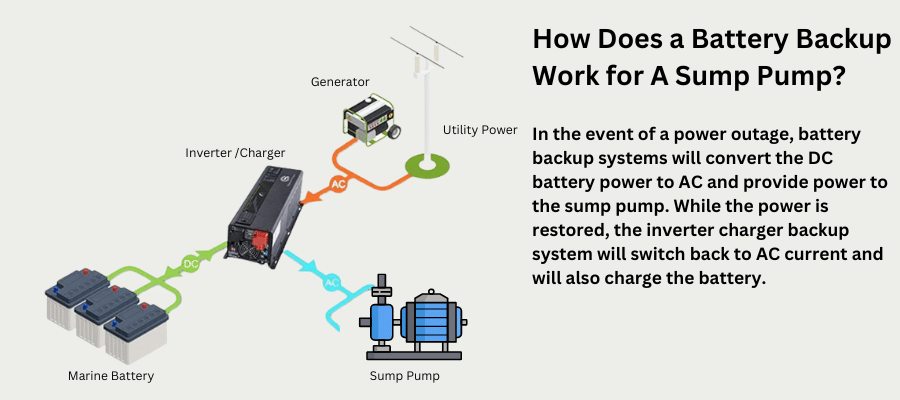
When compared to DC battery run secondary pump systems, which typically operate at fewer gallons per hour (GPH) than primary sump pumps, the first type of system allows your primary pump to keep working while supplying it with the essential power for a much longer amount of time.
Whether it’s in the basement or the crawlspace, you may use the same sump pump that you already have. As opposed to installing a battery backup dual-pump system, which necessitates costly and time-consuming plumbing and electrical work, installing this system is a breeze and can be done in under 15 minutes by retrofitting any existing sump or sewage pump. In contrast to water-powered systems, battery backup systems work without a water supply.
The main disadvantages of sump pump battery backup system, you could be in danger if the pump suddenly stops working. It’s important to keep an eye on your battery’s water levels every few months, clean the terminals twice a year, and replace the battery every five years.
Building a DIY system is much cheaper but comes with other hassles if you are not that technical.
The generator or battery back up size will depend on the HP (1/2 hp, 1/3 hp or 2 hp) of the sump pump and wattage of the other appliances you wish to run. Here is table summing up the generator watts needed for sump pump.
| Sump Pump | Running Watts / Starting Watts | Recommended battery backup system surge wattage |
| 1/3 HP Sump Pump | 800 W / 1300 – 2000 W | 1500 W – 2000W |
| 1/2 HP Sump Pump | 1050 W / 2150 – 4100 W | 2000 – 4000 W |
| 3/4 sump pump | 1050 W / 3000 – 4000 W | 3000 W – 4000 W |
| 1 HP Sump Pump | 1200 W / 3500 – 4500 W | 4000W – 5000 W |
Types of Backup Power for Sump Pumps
- Portable generators — Portable generators with 2000 watt can power your sump pump for days as long as you’ve got gasoline/propane/natural gas ready to use. In addition, a 3,500 to 7,000-watt generator can keep your refrigerator, furnace, and other critical appliances running.
- Standby generators — Automatic and hands-free safety. They do tend to be more expensive than other generators for sump pumps. Not only do they keep more than one appliance running even when the power goes off, but they do so automatically.
- Inverter/Battery backup system for sump pump — These are essentially power inverters made for sump pump. These automatic backup generator for sump pump can run your pump four few hours.
So, if you want our opinion on power inverter vs. generator for sump pump, battery backups or power inverter can run you pump for hours until the battery lasts, on the other hand with a multifuel generator you power you pump until your stored gasoline, propane or natural gas runs out.
If you want a good solar sump pump battery backup then go with indoor solar generators like EcoFlow Delta 1300 is a portable power station.
Sump Pumps with Auto DC Backups
Battery backup sump pumps systems automatically keep your sump pump running for few hours during a power outage by using a backup battery and inverter. We recommend BASEMENT WATCHDOG Big Combo CONNECT Model CITS-50 or the Wayne ESP25 Upgraded pumps.
DIY Sump Pump Backup System w/ Batteries + Power Inverter
How to make battery backup for sump pump? Here is a quick way to make yourself a DIY sump pump backup system. Before you begin you will need:
- Power inverter – See above recommended wattage table for surge watt
- 12-volt deep cycle battery – Read on for recommendation
- 1.5 amp basic an onboard charger – to keep the battery fully charged
Here are some good instruction videos you can watch to build one:
- DIY Battery Backup Sump Pump
- How to Add a Battery Backup to a Sump Pump That Isn’t Compatible With One
Best Battery for Sump Pump Backup
So, what kind of battery for sump pump backup is best? A Deep cycle AGM battery is best type of battery for sump pump backup. Here is a list of best deep cycle battery for backup sump pump:
- WEIZE 12V 100Ah Deep Cycle SLA Battery
- Universal Power Group 12V 100Ah AGM DEEP Cycle VRLA Battery
- Renogy Deep Cycle AGM Battery 12 Volt 100Ah, Marine and Maintenance-Free
- THE BASEMENT WATCHDOG 81.5Ah Maintenance Free (AGM) Sump Pump Battery
The terms “deep-cycle,” “maintenance-free,” “marine,” and “solar” will come up while you’re looking for a backup battery for your sump pump. However, buying the correct one can be challenging because the terms used to denote standby lead-acid batteries are interchangeable.
Let’s decode the battery nomenclature that will help you to find the perfect back up battery for sump pump.
Deep-Cycle Batteries – This word, which refers to the battery’s charging cycle rather than the type of battery, is crucial to understand while looking for a sump pump battery. These batteries are made to undergo continuous charging and discharging, without the battery’s integrity being compromised too quickly.
Marine Batteries – Marine batteries have stronger, elevated plates. This is done to prevent the battery from short-circuiting while the boat is rocking back and forth in rough waves. Marine deep cycle batteries are made to withstand hundreds of charging and discharging cycles while slowly discharging over an extended length of time.
Maintenance-Free Batteries – Depending on the battery type, the term “maintenance-free” may not be accurate. Maintenance-free batteries for wet-cell types are those that are sealed and occasionally valve-regulated (VRLA), which prevents leakage and quick evaporation by reconstituting the H2 and O2 created by the cells back into the water.
Type of Battery for Sump Pump Backup System
- Wet Cell Batteries are the most affordable kind of battery and are most frequently used in automotive applications. They work well in brief bursts to start your vehicle, but you wouldn’t want them to run your sump pump continuously, which is why they’re frequently referred to as “starting batteries.” A deep-cycle variant is the outlier.
- Absorbed Glass Mat (AGM) batteries are a technologically advanced battery that are ideal for backup sump pump systems. AGM batteries have a distinctive architecture that encases the lead-acid cells in a glass fiber that absorbs electrolytes, just enough to keep it wet, won’t leak if punctured, and is reasonably safe to use. The layout enables the cells to be stacked more densely, increasing energy capacity and reducing charging periods. AGM batteries are thought to be truly “maintenance free,”.
- Gel Batteries are similar to a wet-cell battery, with the exception that silica gel is used to fill it with a gelled electrolyte. Gel batteries are ideal in more demanding situations where there are high temperatures and vibrations since the gel will not evaporate, making them another type of “maintenance-free” battery.
Battery Tip: Never store or place a battery directly on the ground, regardless of the type. The battery will become drained if you do this. Use a battery case instead, keep it at least 3–4 feet from the ground.
Best Battery Backup for A Sump Pump – Detailed Review
1. SEC 822PS Sump Pump Backup System
Best Battery Backup for Sump Pump
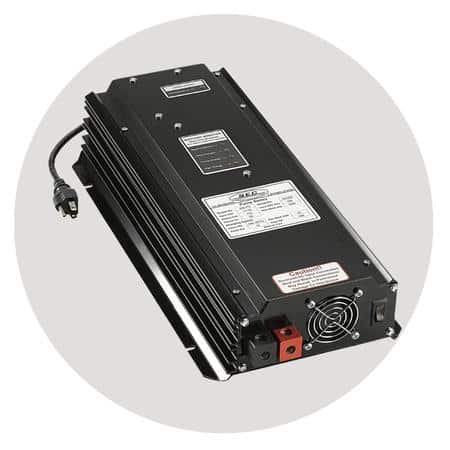
The SEC AMERICA Pump Sentry 822 is an automatic battery backup system designed to keep your sump pump running smoothly even if the power goes out.
This 1200 watt battery back up for a sump pump is small, yet powerful enough to run most 9 amp sump pumps and has lights to show you when it’s time to charge or replace the batteries. It should not be used with any kind of pedestal pump.
This battery backup for basement sump pump is made of durable aluminum, is small in size, can handle the entire pump capacity, is simple to set up, and operates in a noiseless, clean operation.
Connect a 12V deep cycle marine battery with a capacity rating between 90 to 200 Ah using the supplied battery cables for the backup battery to work.
This ups battery backup for sump pump is made and serviced in the USA and is backed by a two-year manufacturer’s warranty.
Customer Review
5 out of 5 star
I used to have a battery backup that was connected to the line with the small pump. It worked, but it was slow. There were times when my basement would have flooded if I had to rely on these modest pumps. This inverter, I believe, will provide me with peace of mind by ensuring that my 1/3 horsepower Zoeller pump will not fail if the power goes out. If you look, the cheap ones cost $400, so why not pay 750 for the actual thing? It’s more than just an inverter; when the power goes out, it automatically switches to battery power, and when the power comes back on, it automatically recharges your battery.
2. PumpSpy 1500W Primary Sump Pump Backup Power System
Check out this battery backup for an existing sump pump from PumpSpy if the price of the PumpSentry inverter is too much to bear. It’s a lot less expensive than the alternatives, and it can run more powerful pumps (up to 3/4 HP) on clean sine wave electricity.
There is protection against overcharging enabled by the battery backup kit for existing sump pump. The battery receives a “trickle charge” to ensure it always has power when needed after being fully charged. For added life and durability, the PumpSpy battery backup unit for sump pump is equipped with a smart cooling feature.
When the power goes out, you no longer have to worry about the basement. This emergency battery backup for sump pump efficient backup unit creates 120 Volt AC that is Pure Sine Wave, which is less noisy and more steady. With a maximum combined current draw of 12.5 Amps, it can power two 1/3 hp primary sump pumps at once at its 1500 Watt output.
In the event of an electrical outage, the add on battery backup for sump pump will provide reliable and efficient power to your sump pump. There are two grounded outlets for your use.
The items we build are sturdy and long-lasting. Using both local and foreign components that are CE-certified for electrical safety, this item is assembled, tested, and packaged in Kalamazoo, Michigan. In addition to its primary function, the rechargeable battery backup for sump pump can be used as a power inverter for a wide variety of devices. Lights, cellphones, monitors, and other electronic gadgets can all be powered by it. The system is ready for installation right out of the box.
3. Xantrex Freedom 806-1840 HF 1800 Inverter Charger for Sump Pump
Among the affordable battery backup power supply for sump pump, the Freedom HF Inverter Charger stands out as one of the smallest, lightest, and most reasonably priced options. Modern Freedom HFs have AC quick-connect connections and a safety lockout switch for the ignition.
Both the AC input and output have quick-connect AC terminals that make installation a breeze and do away with the requirement for strain relief clamps. When the ignition is turned off, the inverter is disabled to prevent unnecessary battery drain.
The Freedom HF Inverter Charger is an ideal solution for powering electronics and small appliances on boats, RVs, and trucks thanks to its modified sine wave output.
To ensure that batteries are charged quickly and efficiently, multistage charging is used. Both an automatic transfer switch and a GFCI outlet are standard on all models. The system can be monitored from remote thanks to a removable digital control panel display that transmits exact system data.
How to Connect a Battery Backup System to A Basement Sump Pump?
To install an inverter charger battery backup system for your sump pump, follow the manufacturer’s instructions as well as any local building rules and restrictions. The following are general steps for attaching a battery backup system to a sump pump:
- Gather the required tools and materials: A drill, drill bits, screwdriver, wire remover, wire connectors, and any other tools and materials specified by the manufacturer will be required.
- Place the battery backup system next to the sump pump: Choose a spot that is convenient and close to an electrical outlet. To mount the system to a wall or other surface, follow the manufacturer’s instructions.
- Connect the sump pump to the backup battery system: Connect the sump pump to the battery backup system using the power lines and connections supplied by the manufacturer. The precise manner of connection will be determined by the system’s design.
- Connect the battery backup system to the main power source: Connect the battery backup system to the main power source using the power cables and connections supplied by the manufacturer. Typically, this will entail connecting a power wire from the system to an electrical outlet or circuit breaker panel.
- Charge the battery: Charge the battery according to the manufacturer’s recommendations. This may entail putting the battery backup system into an electrical outlet and allowing it to charge for a predetermined amount of time.
- Test the system: After connecting and charging the battery backup system, test it to ensure that it is operational. This may entail turning on the sump pump and monitoring the system’s performance.
When connecting a battery backup system to a sump pump, it is important to follow the manufacturer’s instructions as well as any local construction laws and regulations. If you are unsure about any component of the installation process, it is best to engage a licensed electrician to conduct the work.
Battery Back up For Sump Pump – FAQs
Can I Use Car Battery for Backup Sump Pump?
Yes, you can but it won’t last as long a deep cycle marine battery.
How Long Does Battery Backup for Sump Pump Last?
Most brand-new, fully charged batteries will last about 5-6 hours of continuous pumping and about 1-3 days of non-continuous pumping, depending on the frequency, during a power outage. Power decreases as the pump operates for longer periods of time. Also, the run-time is shorter for larger pumps.
There are three primary considerations when selecting a battery backup system for an existing sump pump:
- Power consumption (amps)
- Capacity (in amp-hours) of the battery
- Duty cycle: the ratio of the on/ off time
For example, a pump with 6 running amps that operates for 10 seconds every 5 minutes, then it can run up to 51 hours. Calculate yours with the battery backup for sump pump runtime calculator.
Do I Need a Battery Backup for My Sump Pump?
Having a battery backup system for your sump pump is crucial if you want to rest easy knowing that your home is safe from flooding.
How Much Does a Battery Backup for Sump Pump Cost?
A decent battery backup system for sump pump can cost from $670 to $1000.
What Size Battery for Sump Pump Backup?
For most backup systems we recommend you use a 12 V DC deep cycle marine battery with at 80-100 Ah.
How to Protect Your Sump Pump?
If water gets into your basement, even a small amount can cause a lot of problems. If your basement is always damp, mold will thrive there, too.
Even though a sump pump can help you avoid flooding in the basement, regular maintenance is essential to working that it continues to function properly. There are some easy steps you can take to keep your pump running well.
1. Simple Maintenance
To begin with, check sure the motor is working properly on your sump pump. Pull the float up. If the pump still isn’t running, start to see if the device is plugged in and receiving power.
Next, check that the length of the discharge line is sufficient to divert water far enough away from your home. If it doesn’t, you may need to have it relocated, expanded, or rebuilt by a specialist.
The sump pump should also be connected to a backup power source. This contains a backup generator. A secondary electric pump, a pump powered by a backup battery, or a hydraulic pump are all backup alternatives. Because it doesn’t need batteries or electricity, a hydraulic pump can be used even when there is a prolonged blackout.
2. Prevent Overflow
Any time normal rainfall exceeds the capacity of a sump pump, the pump will be overwhelm. Heavy rain, or a buildup of ice on the discharge line can all cause an overflow.
Check the basin for debris and clear it out if you want to avoid an overflow. The check valve, then, has to be looked at. It prevents water from being sucked back into the pump after being released.
The weep hole, a small opening in the discharge pipe designed to prevent air lock, should be cleaned as needed with a pin. It is also important to check and clean the impeller, which does the actual work of propelling water. If it becomes blocked or broken, it will produce a funny noise or turn off the pump.
3. Other Things to Keep in Mind
Multiple pumps necessary for particularly large residences or buildings. A secondary sump pump can be installed if the primary one isn’t effectively preventing water from entering the basement.
The sump should not be placed directly on the ground but rather on a pedestal.
Last but not least, check sure the float switch is working. It can become caught in the moving elements of the pump or jammed against a wall in particular designs. In order to work effectively, it must be freestanding.
Generator Backup for Sump Pump – Conclusion
If your sump pump stops working because of a power outage, the resulting repairs might cost you thousands of dollars. Portable generators that are up to code with the EPA and CARB can help you power essentials like basement pumps and refrigerators.
Other ways people find this article:
Read Next:
- largest inverter style generator
- Who Really Makes Which Generator? – The Real Truth


